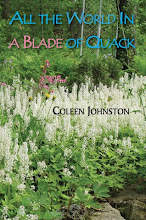Most of the time, I add plants to the garden for their beautiful color or the wonderful shape of their flower. Sometimes I add them because they are passalongs from friends who have recommended them. Once in a while, I add them because they look so beautiful in a catalog. This one, I added because I loved the name. Astilboides. I wasn't even sure how to pronounce it when I sent for it from White Flower Farm--the first time. Yes, some years back I spent $24 on a bare root that looked sort of like an iris rhizome. I planted it. It didn't come up. I dug it up and replanted it. Nothing. I chalked it up to pilot error and threw in the trowel, so to speak.
A couple of years later, gnawed at by my failure, I ordered another one of these expensive little numbers and tried again, only to fail again. They must not grow in Minnesota, I decided--but then I saw one in a friend's garden. Her dinner-plate leaves looked just like the ones in the catalog! My failure ran deep and complete until last year's White Flower Farm catalog offered the plant for $14, a price obviously intended to attract fools like me who just don't know when to quit. To my great surprise, this one sprouted soon after planting. Then it grew. Now, in year two, it shows the promise of what it may become if the attendant climbing hydrangeas don't overpower it. Will they be friends, or enemies? Does failure lurk ahead? Check Bloom Chronicles next summer--and please, don't encourage me to ever buy another if this one fails, no matter how wonderful the word "Astilboides."
Poem of the Week, by Kaylin Haught
7 years ago















